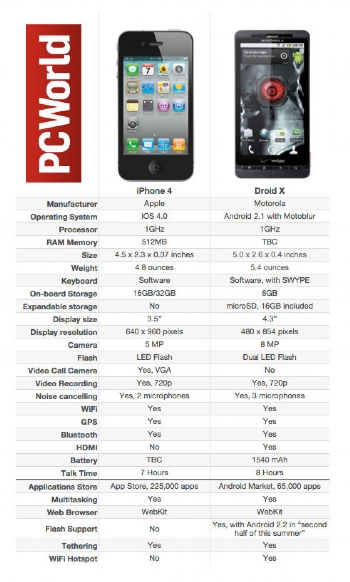Retina display! 8-megapixel camera! Video calls! HDMI port! The last few days have seen lots of shouting from proponents of the hot phones of the minute, the Apple iPhone 4s and the Motorola Droid X. Which phone really delivers the best experience? We got our hands on both and tested them in seven categories: cost of ownership, storage, connection speeds, still and video image capture, display and resolution, operating system, and multitasking and media playback.
The iPhone 4s won the majority of our battles–but barely. Both phones are incredibly fast, have superb displays, and come loaded with multimedia features. Some of our tests, such as OS and media playback, come down to personal preference. On the other hand, our display, still camera, and camcorder tests clearly prove that the iPhone 4s is stronger in those categories. And the iPhone 4s won our data-speed and voice-quality tests, though they were confined to San Francisco; the results could be different in other parts of the country.
Soon, we’ll be putting the HTC EVO 4G and the Samsung Galaxy S through the same testing, so check back for those results.
onnectivity: Data Speeds and Voice Quality
The Stats: In the connectivity department, the Droid X and the iPhone 4s both come with Wi-Fi, GPS, and Bluetooth. What the Droid X can do and the iPhone 4s can’t is to act as a mobile hotspot. For an extra $20 per month, the Droid X allows you to connect up to five compatible Wi-Fi devices, such as your laptop, your iPad, or other gadgets, to Verizon’s network.
Both phones boast noise-cancellation technology, which is supposed to improve call quality by blocking sounds around you, leaving only your voice.
Testing Methodology: We tested the iPhone 4s and the Droid X in five San Francisco locations and used the same testing methodology we use for our 3G speed tests. We used the FCC-endorsed Ookla testing app on both the iPhone 4s and the Droid X to measure upload speeds and download speeds. The Ookla test sends a stream of packets from the phone to a network server and back, and then measures the average speeds at which the packets make the round trip. We ran three consecutive speed tests on each phone at each location and then picked the best upload and download speeds of the three. Our voice-call tests were more subjective; we placed calls to a common local number, listening for static, jitter, delay, dropped calls, or a failure to connect, and then assigned a score to each call.
Data Speed Winner: iPhone 4s
In our informal performance testing in San Francisco, the AT&T-connected iPhone 4s registered far faster download speeds than the Verizon-connected Droid X did. The iPhone 4s showed an average download speed of 1958 kbps (almost 2 mbps) across our five testing locations in the city. The Droid X had an average download speed of 1130 kbps–still more than enough speed for reasonably fast Web browsing and standard-definition video watching. The two new devices posted similar average upload speeds; the iPhone4 registered 434 kbps and the Droid X averaged 564 kbps. Those upload speeds are fast enough to support basic file sharing but not enough to make fat-pipe apps such as multiplayer gaming or videoconferencing run well.
Voice Quality Winner: iPhone 4s
The iPhone 4s showed an even greater advantage over the Droid X in our voice-call quality tests. In almost all the test calls we placed around the city, calls on the iPhone 4s sounded better than the Droid X. Calls sounded more natural, and were more pleasing to listen to on the other end of the line. We recorded no dropped calls on AT&T.
In test calls using the Droid X, the audio coming out of the earphone was usually clear enough, but it didn’t sound as full and pleasing as that coming out of the iPhone 4s. On the other end, I’m told, my voice sounded loud enough, but not as dynamic and even a bit shrill. We also noted some minor static on some calls, as well as a warbling sound in other calls. We recorded only one dropped call using the Droid X.
Obviously, you can’t generalize too much from these tests. We were able to test in only one city, and testing over wireless networks is inherently unpredictable–weather and network traffic can affect the results in unknown ways.
Still Camera
The Specs: The iPhone 4s sports a 5-megapixel camera sensor with an LED flash, which is a nice upgrade from the iPhone 3GS’s 3-megapixel camera with no flash. The camera supports tap-to-focus in shooting mode, as well as photo geotagging.
On paper, the Droid X’s camera seems a bit stronger. It has an 8-megapixel display with a dual-LED flash. The Droid X offers no tap-to-focus, but it does have a face-detection feature that will automatically focus on a (human) subject. In addition to an Auto mode, the Droid X has a handful of basic scene modes that you can adjust based on the shooting environment: Landscape, Portrait, Macro, Sports, Steady Shot, Sunset, and Night Portrait.
Testing Methodology: PCWorld’s testing methodology for the iPhone 4 and Droid X cameras was a truncated version of our regular testing methodology for point-and-shoot cameras. We affixed each phone to a tripod and shot two images with the flash turned off:
1. One still-life scene with a color chart and delightful random objects to rate exposure quality and color accuracy.
2. A target chart and printed text to evaluate sharpness and distortion levels.







0 comments:
Post a Comment